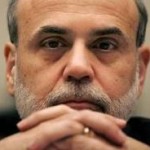…We can’t rule out the possibility that, at some point in the next few  years, our economy will slow, perhaps significantly. How would the Federal Reserve respond? What tools remain in the monetary toolbox? In this and a subsequent post, I discuss some policy options the Fed might consider, focusing first on negative interest rates.
years, our economy will slow, perhaps significantly. How would the Federal Reserve respond? What tools remain in the monetary toolbox? In this and a subsequent post, I discuss some policy options the Fed might consider, focusing first on negative interest rates.
By Ben Bernanke
First steps for easing policy
…Given where we are today, how would the Fed respond to a hypothetical economic slowdown?
- Unfortunately, with the fed funds rate (the Fed’s target short-term rate) now between ¼ and ½ percent, and likely to remain relatively low, moving to zero provides much less firepower than in the past…
- If the Fed can convince market participants that short-term rates will stay low for some time, it can “talk down” longer-term rates, such as mortgage rates, which are typically more important to consumers, businesses, and investors…The evidence suggests that forward guidance can be quite powerful, and if the amount of extra policy support needed is not too great.
- Like forward guidance, the goal of QE is to reduce longer-term interest rates to encourage borrowing and spending. It appears to work through at least two channels.
- First, the Fed’s purchases push up the price and (equivalently) push down the yield of the assets it buys. That effect is transmitted through the system as investors who sold the assets shift into others (such as stocks or corporate bonds).
- Second, the Fed’s asset purchases can help signal its intention to keep rates low for a long time…[but] the FOMC might be reluctant to turn to it again.
- It’s hard to calibrate, and communicating about it is difficult (as we learned in 2013 when Fed talk about ending QE led to a “taper tantrum” in financial markets).
- It’s also possible that a new round might be less helpful than before.













Leave A Comment